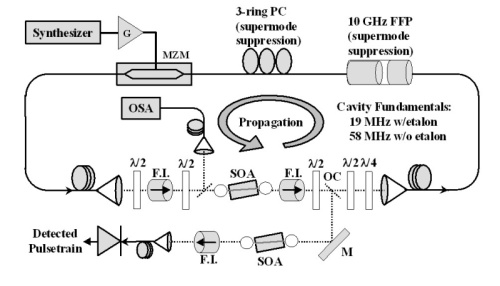This course deals with the fundamentals and applications of the generation, transmission, detection and manipulation of high speed optical signals. The course is broadly divided into four sections. The first part of the course discusses the primary methods used to generate high speed optical signals. The second part introduces methodologies for the detection, measurement, and characterization of optical signals that are beyond the capabilities of conventional electronics. The third part deals with high speed optical signal transmission, including linear and nonlinear pulse propagation, as well as mathematical methods for predicting the temporal and spectral characteristics that are affected by nonlinear effects. The final part of the course describes critical signal processing techniques for future optical communication networks, computer interconnects and advanced ultrahigh speed signal processing.
Pre-requisites: Graduate Standing, OSE 6111 and OSE 6525 or PHY 5346, or Consent of Instructor
List of topics
Introduction
- Definition of Electric Fields,
- Intensity,
- Spectral Field & Intensity,
- Temporal and Spectral Phase,
- Instantaneous Frequency & Group Delay,
- Dispersion & Dispersion Engineering
- (Computer Project of Linear Pulse Propagation).
High Speed Optical Signal Generation
- Modelocking (active, AM±FM, passive via saturable absorber/saturable gain, Kerr lensing, other nonlinear effects),
- Gain Switching,
- Direct Modulation,
- Attosecond pulse generation
- (Computer Project – Numerical Simulation of Passive Modelocking w/ Gain Saturation).
High Speed Signal Detection
- High speed photodetectors (PIN, avalanche, photoconductive),
- streak camera,
- nonlinear optical correlation techniques,
- joint time-frequency measurements
- (computer simulation of autocorrelation, spectrogram & SHG FROG).
High Speed Optical Signal Transmission
- Optical fibers,
- pulse compression ,
- soliton propagation,
- Bragg reflectors,
- saturable absorption,
- gain saturation,
- group delay dispersion
- (Computer project: nonlinear pulse propagation/solitons; pulse compression).
Signal Processing
- Pulse shaping,
- arbitrary waveform generation (optical and RF),
- optical sampling,
- optical analog to digital converters,
- computing and logic,
- nonlinear switching,
- photonic network architectures (OTDM, DWDM, OCDMA),
- mixed signal analysis.
Recommended Reference Materials
- Ultrafast Optics, A. M. Weiner, Wiley, 2009, ISBN 978-0-471-41539-8.
- Ultrashort Laser Pulse Phenomena, J. C. Diels & W. Rudolph, Academic Press, 1996, ISBN 0-12-215492-4
- Laser Electronics, 3rd. Ed., J.T. Verdeyen, Prentice Hall, 1995, ISBN 0-13-706666-X
- Ultrashort Laser Pulses & Applications, W. Kaiser, Ed., Springer Verlag, (1988).
- Principles and Applications of Optical Communications, M. K. Liu, IRWIN, 1996, ISBN 0-256-16415-0.
- Fundamentals of Photonics, B. Saleh & M. Teich, J. Wiley (1991)
- Optical Fiber Communications III A & III B, I. P. Kaminow, T. L. Koch, Academic Press (1997) ISBN 0-12-395170-4.
- Compact Sources of Ultrashort Pulses, I. Duling, Ed., Cambridge University Press (1995) ISBN 0-521-46192-8.
- Ultrafast Lasers, Technology & Applications – M. Fermann, et al.,Marcel Dekker (2003) ISBN 0-8247-0841-5.

Low Noise Modelocked Semiconductor Optical Clock